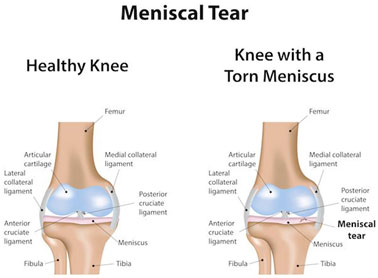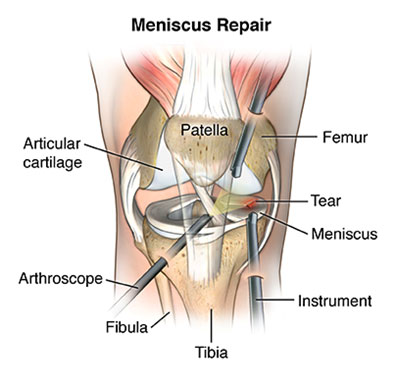Meniscus Tear
The meniscus is a piece of cartilage that provides a cushion between your femur and tibia. There are two menisci in each knee joint. They can be damaged on torn during activities that put pressure on or rotate the knee joint.
There are many cause for that:
1. Traumatic Tear: -
- During activities that cause direct contact a pressure from a forced twist or rotation.
- A sudden pivot turn, deep squatting or heavy lifting can lead to injury
- Many athletes are at risk for a meniscus tear.
- Sports that require sudden turns and stops may put you at higher risk for meniscus tear.
- Sports include:-
- Football
- Basketball
- Soccer
- Tennis
2. Degenerative Tear: -
- Mainly older age

Symptoms of the patient: -
Depends on severity:-
• Grade 1 :-minor pain
• Grade 2:-moderate pain
• Grade 3:- severe pain and total torn meniscus
Other symptoms are: -
• Pain especially when the area is touches
• Swelling
• Difficulty moving your knee or inability to move it in a full ROM
• The feeling that your knee is giving way or unable to support you
• Slipping or popping sensation
0rthopedics surgeon clinically check for tenderness area of pain
perform clinical test: -
MacMurray test: - to look for a meniscal tear. This test involves bending your sknee and then straightening and rotating it. You may hear a slight pop during this test. This can indicate a tear of the meniscus.
Epley’s test: - The patients lie on his or her stomach, bending the knee at an even 90-degree angle. Downward force will be applied to the foot by the physician while the foot is rotated to the outside. If pain present itself in the inner section of the knee joint, a medial meniscal tear may be present.
Image in test:-

This test won’t show meniscus tear. It can be helpful to determine if there are any other cause of your knee pain like OA.
MRI: - meniscus tear may not show up on an MRI because they are closely resembled degenerate or age-related changes.
Ultrasound: - uses sound waves to take images inside the body. This will determine if you have any loose cartilage that may be getting caught in your knee.
Arthroscopy: - If your doctor is unable to determine the cause of your knee pain from these techniques. They may suggest arthroscopy to study your knee.
Treatment for meniscal injury
• Rest the knee
• Ice your knee
• Compress your knee
• Elevate your knee
• Use stretching and strengthening exercise to help reduce stress to your knee
• Avoid impact activities such as running and jumping

Why arthroscopy better than open surgery
Meniscus tear is mild (Grade 1 or 2) you may not need surgery, it is Grade 3, you probably will your doctor might choose to day of the followingArthroscopic repair: - your doctor will make small cuts in your knee, he’ll insert an arthroscope to get a good look device that look like darts along the tear to stitch up. Your body will absorb those over time.
Arthroscopic partial meniscectomy:- remove a piece of the torn meniscus so your knee can function normally
Arthroscopic total meniscectomy: - your doctor will remove the whole meniscus.
The meniscus is a piece of cartilage that provides a cushion between your femur and tibia. There are two menisci in each knee joint. They can be damaged on torn during activities that put pressure on or rotate the knee joint.
There are many cause for that:
1. Traumatic Tear: –
- During activities that cause direct contact a pressure from a forced twist or rotation.
- A sudden pivot turn, deep squatting or heavy lifting can lead to injury
- Many athletes are at risk for a meniscus tear.
- Sports that require sudden turns and stops may put you at higher risk for meniscus tear.
- Sports include:-
- Football
- Basketball
- Soccer
- Tennis
2. Degenerative Tear: –
- Mainly older age




